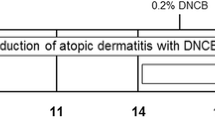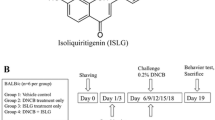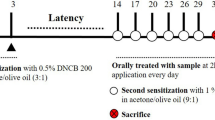Abstract
Atopic dermatitis (AD) is a skin disease characterized by pruritus. The present study aimed to discover a herbal combination with anti-allergic and anti-inflammatory activities to treat AD. First, the anti-allergic and anti-inflammatory activities of herbs were evaluated by RBL-2H3 degranulation and HaCaT inflammatory models. Subsequently, the optimal proportion of herbs was determined by uniform design-response surface methodology. The effectiveness and synergistic mechanism was further verified. Cnidium monnieri (CM) suppressed β-hexosaminidase (β-HEX) release, saposhnikoviae radix (SR), astragali radix (AR), and CM inhibited the release of IL-8 and MCP-1. The optimal proportion of herbs was SR∶AR∶CM = 1: 2: 1. The in vivo experiments results indicated that the topical application of combination at high (2 ×) and low (1 ×) doses improved dermatitis score and epidermal thickness, and attenuated mast cell infiltration. Network pharmacology and molecular biology further clarified that the combination resisted AD by regulating the MAPK, JAK signaling pathways, and the downstream cytokines such as IL-6, IL-1β, IL-8, IL-10, and MCP-1. Overall, the herbal combination could inhibit inflammation and allergy, improving AD-like symptoms. The present study discovers a promising herbal combination, worthy of further development as a therapeutic drug for AD.
Graphical abstract













Similar content being viewed by others
Data availability
The data used to support the findings of this study are included within the article, and further details are available from the corresponding author upon request.
Abbreviations
- AD:
-
Atopic dermatitis
- TCM:
-
Traditional Chinese medicine
- β-HEX:
-
β-Hexosaminidase
- SR:
-
Saposhnikoviae radix
- CM:
-
Cnidium monnieri
- AR:
-
Astragali radix
- DNCB:
-
2,4-Dinitrofluorobenzene
- IgE:
-
Immunoglobulin E
- IL-8:
-
Interleukin-8
- DNCB:
-
2,4-Dinitrochlorobenzene
- MCP-1:
-
Monocyte chemoattractant protein-1
- KF:
-
Ketotifen fumarate
References
Yew YW, Thyssen JP, Silverberg JI (2019) A systematic review and meta-analysis of the regional and age-related differences in atopic dermatitis clinical characteristics. J Am Acad Dermatol 80(2):390–401
Weidinger S, Novak N (2016) Atopic dermatitis. Lancet 387(10023):1109–1122
Misery L (2017) Burden of atopic dermatitis in adults. Ann Dermatol Venereol 144:S23–S28
Misery L (2020) Burden of atopic dermatitis in children and adolescents. Ann De Dermatol et de Venereol 147(11):11S31-11S36
Tsianakas A, Stander S (2016) Dupilumab: a milestone in the treatment of atopic dermatitis. Lancet 387(10013):4–5
Chiricozzi A et al (2020) Topical corticosteroids for pediatric atopic dermatitis: thoughtful tips for practice. Pharmacol Res 158:104878
Hussain Z et al (2017) Phytotherapeutic potential of natural herbal medicines for the treatment of mild-to-severe atopic dermatitis: a review of human clinical studies. Biomed Pharmacother 93:596–608
Zhou MM et al (2017) Recent pharmaceutical evidence on the compatibility rationality of traditional Chinese medicine. J Ethnopharmacol 206:363–375
Werfel T et al (2016) Cellular and molecular immunologic mechanisms in patients with atopic dermatitis. J Allergy Clin Immunol 138(2):336–349
Tsakok T et al (2019) Atopic dermatitis: the skin barrier and beyond. Br J Dermatol 180(3):464–474
Modena BD, Dazy K, White AA (2016) Emerging concepts: mast cell involvement in allergic diseases. Transl Res 174:98–121
Albanesi C (2010) Keratinocytes in allergic skin diseases. Curr Opin Allergy Clin Immunol 10(5):452–456
Goleva E, Berdyshev E, Leung DYM (2019) Epithelial barrier repair and prevention of allergy. J Clin Investig 129(4):1463–1474
Fitzgerald KA, Kagan JC (2020) Toll-like Receptors and the Control of Immunity. Cell 180(6):1044–1066
Pasparakis M, Haase I, Nestle FO (2014) Mechanisms regulating skin immunity and inflammation. Nat Rev Immunol 14(5):289–301
Proksch E, Brasch J (2012) Abnormal epidermal barrier in the pathogenesis of contact dermatitis. Clin Dermatol 30(3):335–344
Lotia S et al (2013) Cytoscape app store. Bioinformatics 29(10):1350–1351
Bindea G et al (2009) ClueGO: a Cytoscape plug-in to decipher functionally grouped gene ontology and pathway annotation networks. Bioinformatics 25(8):1091–1093
Huang DW, Sherman BT, Lempicki RA (2009) Systematic and integrative analysis of large gene lists using DAVID bioinformatics resources. Nat Protoc 4(1):44–57
Davis RR et al (2021) Structural insights into JAK2 inhibition by ruxolitinib, fedratinib, and derivatives thereof. J Med Chem 64(4):2228–2241
Qiu J, Grine K (2016) Complementary and alternative treatment for allergic conditions. Prim Care 43(3):519
Kreiner J et al (2017) Saposhnikoviae divaricata: a phytochemical, pharmacological, and pharmacokinetic review. Chin J Nat Med 15(4):255–264
Wang EB et al (2019) Comparison of aerial parts of Astragalus membranaceus and Astragali Radix based on chemical constituents and pharmacological effects. Food Hydrocolloids 30(1):1046–1066
Li YM et al (2015) Cnidium monnieri: a review of traditional uses, phytochemical and ethnopharmacological properties. Am J Chin Med 43(5):835–877
Hammad H, Lambrecht BN (2015) Barrier epithelial cells and the control of type 2 immunity. Immunity 43(1):29–40
Park JH et al (2020) Combretum quadrangulare extract attenuates atopic dermatitis-like skin lesions through modulation of MAPK signaling in BALB/c mice. Molecules 25(8):2003
Rodrigues MA, Torres T (2020) JAK/STAT inhibitors for the treatment of atopic dermatitis. J Dermatol Treat 31(1):33–40
Leung DYM et al (2004) New insights into atopic dermatitis. J Clin Investig 113(5):651–657
Guttman-Yassky E, Krueger JG, Lebwohl MG (2018) Systemic immune mechanisms in atopic dermatitis and psoriasis with implications for treatment. Exp Dermatol 27(4):409–417
Peng W, Novak N (2015) Pathogenesis of atopic dermatitis. Clin Exp Allergy 45(3):566–574
Kaesler S et al (2014) Toll-like receptor 2 ligands promote chronic atopic dermatitis through IL-4-mediated suppression of IL-10. J Allergy Clin Immunol 134(1):92
Funding
This work was supported by the National Natural Science Foundation of China (No. 82073996).
Author information
Authors and Affiliations
Contributions
YR: Conceptualization, Visualization, Writing—Original Draft. QW: Data curation, Validation. CL: Investigation. JZ: Formal analysis. ZW: Validation. YL: Software. YZ: Supervision, Writing—Review and Editing. All authors read and approved the final manuscript.
Corresponding author
Ethics declarations
Conflict of interest
The authors declare no conflict of interest.
Additional information
Publisher's Note
Springer Nature remains neutral with regard to jurisdictional claims in published maps and institutional affiliations.
Rights and permissions
Springer Nature or its licensor (e.g. a society or other partner) holds exclusive rights to this article under a publishing agreement with the author(s) or other rightsholder(s); author self-archiving of the accepted manuscript version of this article is solely governed by the terms of such publishing agreement and applicable law.
About this article
Cite this article
Ren, Y., Wu, Q., Liu, C. et al. Discovery of a traditional Chinese herbal combination for the treatment of atopic dermatitis: saposhnikoviae radix, astragali radix and cnidium monnieri. Arch Dermatol Res 315, 1953–1970 (2023). https://doi.org/10.1007/s00403-023-02575-9
Received:
Revised:
Accepted:
Published:
Issue Date:
DOI: https://doi.org/10.1007/s00403-023-02575-9




